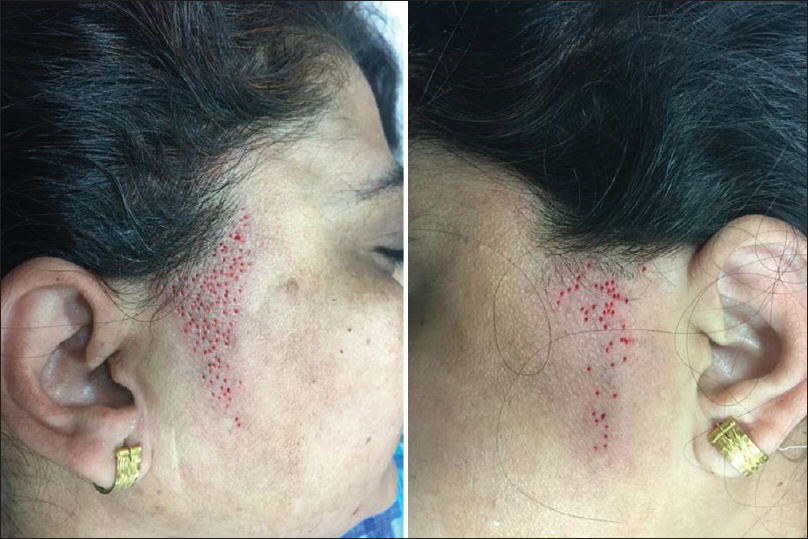Translate this page into:
White Hair Removal with Follicular Unit Extraction
Address for correspondence: Dr. Jyoti Gupta, First Floor, Shivalik, New Delhi - 110 017, India. E-mail: Jkgarg12@gmail.com
This is an open access article distributed under the terms of the Creative Commons Attribution-NonCommercial-ShareAlike 3.0 License, which allows others to remix, tweak, and build upon the work non-commercially, as long as the author is credited and the new creations are licensed under the identical terms.
This article was originally published by Medknow Publications & Media Pvt Ltd and was migrated to Scientific Scholar after the change of Publisher.
Dear Editor,
White hairs have proven refractory to any kind of photoepilation technology because of the absence of melanin chromophore in the hair follicle. Many treatment protocols have been tried, but none of them have been effective treatment. We, herein, present a case report of a 40-year-old woman with white hair successfully removed via follicular unit extraction (FUE).
A 40-year-old woman presented for laser hair reduction of excessive hairs on sideburns. On examination, the patient had both black and white hairs with hyperpigmentation present over the sideburns due to repeated hair dye application [Figure 1]. She was started on diode laser for black hair and FUE was planned 2 weeks later for the removal of white hair.

- Baseline photograph of the white hair present over both sideburns
Informed consent was obtained. Under aseptic conditions, all hairs were cut to a length of 1–2 mm. Under local anaesthesia and proper magnification, a motorised, sharp-walled, 0.8 mm, serrated punch was used for scoring of follicles [Figure 2]. The follicles were extracted via forceps and inspected for any transection [Figure 3]. Dressing was done for 24 h and a topical antibiotic cream was given for 5 days.

- Immediately after follicular unit extraction

- Intact follicles
A total of 116 hairs on the right side and 45 hairs on the left side were removed in three sessions at an interval of 4 weeks each [Figure 4]. The transection rate of follicle was kept below 5%. There was no regrowth, visible scarring or pigmentary anomaly present in the treated area after 5 months of the first session.

- Photograph after three sessions
The present scenario shows an innovative method to eliminate white hair. Because of the absence of any chromophore, photoepilation is not effective in this kind of hair. Many light- and heat-based therapies have been tried for white hair removal such as use of radiofrequency,[1] laser after colouring[2] or use of melanin-encapsulated liposomes[3] before laser therapy. However, none of them have proven to be an effective therapy with results varying 17%–54%.
Till date, electrolysis is considered to be the treatment of choice.[4] There are chances of folliculitis, post-inflammation hyperpigmentation and scarring if electrolysis current is applied at too high a level. Further, since only dermal papilla is destroyed in electrolysis procedure, there are chances of regrowth from upper portions of the follicle (bulge region). Electrolysis can sometimes take up to twenty sessions for complete removal of the hair.
With FUE, provided the transection rate is kept below 10%, a complete follicle is removed leading to permanent removal of the hair in 2–3 sessions conserving both time and finance as compared to other procedures routinely used. With punch size of 0.8 mm, there are very minimal chances of any visible scarring or pigmentary anomaly. However, pigmentation cannot be ruled out completely in dark-skinned individuals. With experience, one can extract up to 2000 follicles in an hour which is much faster than any other option available for white hairs. In our opinion, FUE can become an effective, safe and fast way for removal of the white hair.
Financial support and sponsorship
Nil.
Conflicts of interest
There are no conflicts of interest.
REFERENCES
- Effective epilation of white and blond hair using combined radiofrequency and optical energy. J Cosmet Laser Ther. 2004;6:27-31.
- [Google Scholar]
- Successful white hair removal with combined coloring and intense pulsed light (IPL): A randomized clinical trial. Photomed Laser Surg. 2011;29:773-9.
- [Google Scholar]
- A randomized, controlled, double-blind study evaluating melanin-encapsulated liposomes as a chromophore for laser hair removal of blond, white, and gray hair. Ann Plast Surg. 2007;58:551-4.
- [Google Scholar]
- Electrolysis: Observations from 13 years and 140,000 hours of experience. J Am Acad Dermatol. 1995;33:662-6.
- [Google Scholar]





